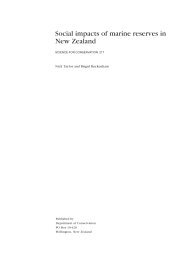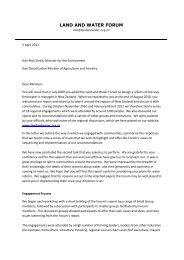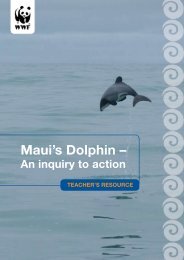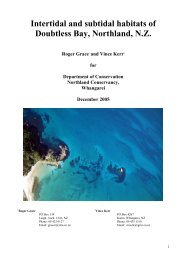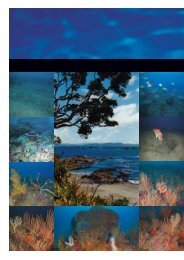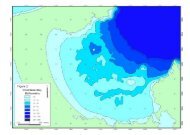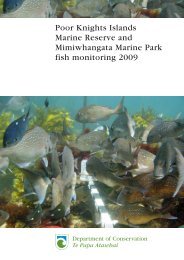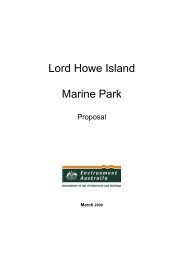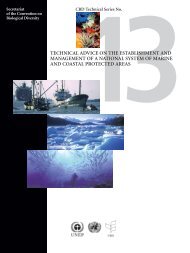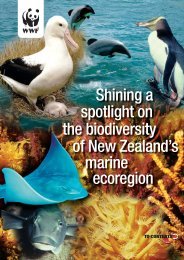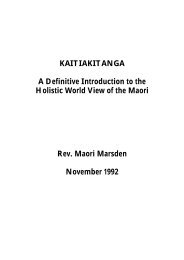Habitats and Ecological Values of the Hokianga ... - MarineNZ.org.nz
Habitats and Ecological Values of the Hokianga ... - MarineNZ.org.nz
Habitats and Ecological Values of the Hokianga ... - MarineNZ.org.nz
Create successful ePaper yourself
Turn your PDF publications into a flip-book with our unique Google optimized e-Paper software.
R.J. DAVIDSON: V. KERR<br />
HABITATS AND ECOLOGICAL VALUES OF HOKIANGA HARBOUR<br />
2.2.3 Areas <strong>of</strong> Particular Importance to Birds<br />
As part <strong>of</strong> <strong>the</strong> present study, areas important to birds were identified <strong>and</strong> described. A variety <strong>of</strong><br />
wildlife habitats are known from <strong>Hokianga</strong> Harbour. Each habitat is utilised by a variety <strong>of</strong> bird<br />
communities.<br />
The range <strong>of</strong> habitats have been summarised as follows:<br />
• open tidally flooded mud <strong>and</strong> s<strong>and</strong> flats;<br />
• beaches;<br />
• s<strong>and</strong> dunes;<br />
• cobble, boulder <strong>and</strong> rock;<br />
• native rush-l<strong>and</strong>s <strong>and</strong> peripheral shrubs;<br />
• Spartina grassl<strong>and</strong>;<br />
• permanent water;<br />
• shallow water (< 0.5 m depth);<br />
• deep water (> 0.5 m depth);<br />
• peripheral trees;<br />
• tidal freshwater vegetation;<br />
• native herb-field;<br />
• artificial structures; <strong>and</strong><br />
• isl<strong>and</strong>s.<br />
Open tidally flooded mud <strong>and</strong> s<strong>and</strong> flats<br />
This feeding habitat is utilised by a variety <strong>of</strong> wading bird species including regularly observed<br />
species such as b<strong>and</strong>ed dotterel, pied stilt, godwit <strong>and</strong> ducks <strong>and</strong> less frequent visitors such as lesser<br />
knot <strong>and</strong> wrybill. These mud <strong>and</strong> s<strong>and</strong> flat areas support invertebrates including shellfish (e.g.<br />
cockles), snails, crabs <strong>and</strong> worms that provide a staple food for many different wader bird species.<br />
Large areas <strong>of</strong> s<strong>and</strong> flat occur in <strong>the</strong> lower Harbour (i.e. Onoke to <strong>the</strong> entrance), while large areas <strong>of</strong><br />
mudflat occur in <strong>the</strong> central <strong>and</strong> upper Harbour. According to Davis <strong>and</strong> Bellingham (1984) some<br />
separation in species utilisation between s<strong>and</strong> flats <strong>of</strong> <strong>the</strong> lower Harbour <strong>and</strong> <strong>the</strong> mudflats in <strong>the</strong><br />
central <strong>and</strong> upper Harbour occur. For example, waders excluding stilts <strong>and</strong> herons tended to utilise<br />
<strong>the</strong> s<strong>and</strong> flats <strong>of</strong> <strong>the</strong> lower Harbour.<br />
Beaches<br />
Relatively large areas <strong>of</strong> beach habitat is located between <strong>the</strong> nor<strong>the</strong>rn entrance to Waitapu. These<br />
areas are import to roosting waders such as New Zeal<strong>and</strong> dotterel, wrybill <strong>and</strong> b<strong>and</strong>ed dotterel.<br />
S<strong>and</strong> dunes<br />
Extensive dune areas are located at <strong>the</strong> north head <strong>of</strong> <strong>the</strong> Harbour. These areas are used as breeding<br />
sites by variable oystercatcher, black-backed gull <strong>and</strong> New Zeal<strong>and</strong> dotterel.<br />
PAGE 11 3/06/2005 DAVIDSON ENVIRONMENTAL LTD 389/2001





